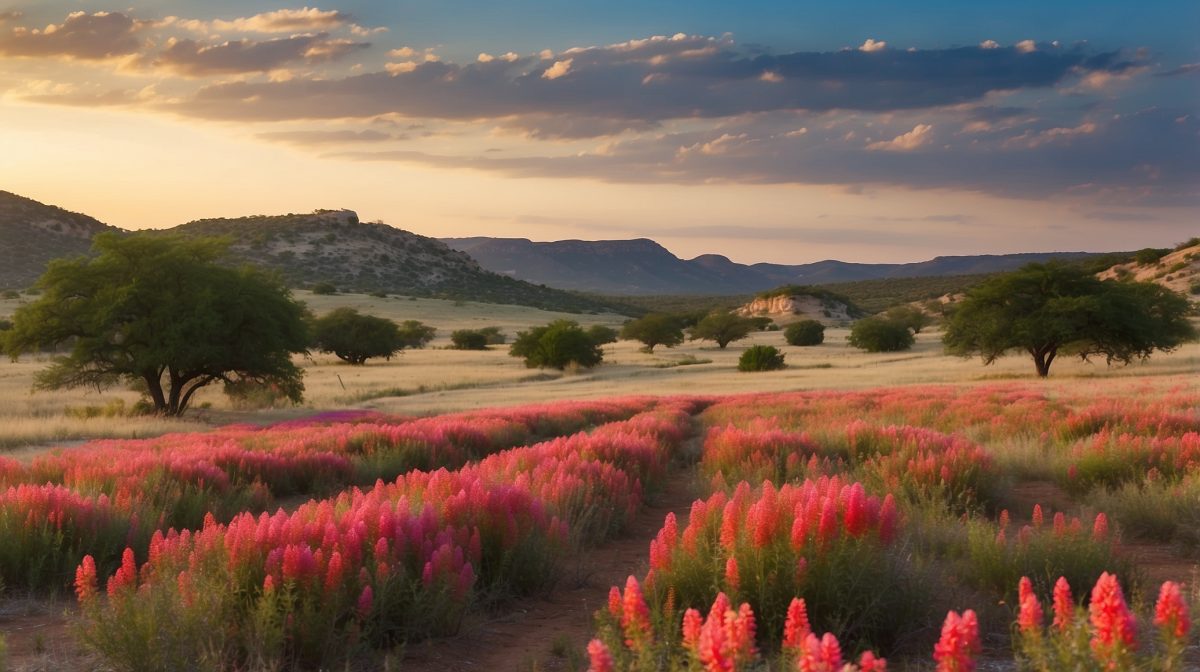Take it from a Texas Hill Country native who’s been knee-deep in this soil since I could walk. I’ve seen firsthand how the right touch can turn a patch of land into a veritable Garden of Eden, right here at the JL Bar Ranch Resort. We’ve got the know-how and the elbow grease to make any plant thrive, so let’s dig in and explore what grows best in our beloved Hill Country.
The Richness of Texas Hill Country Soil
Now, the soil ’round these parts is as varied as the folks that settled here. From the rich, black dirt that’s perfect for your wildflowers and veggies, to the rocky limestone that our native plants just love, there’s a patch of ground for every kind of green thumb. But remember, it ain’t just about what’s on top; it’s what you do with it that counts.
Here’s a tip straight from the horse’s mouth: get to know your land. Some plants are gonna want more drainage, while others are hankering for a bit of clay. And don’t be shy about mixin’ in some compost or organic matter—that’s like a hearty Texas stew for your plants. It’ll help ’em grow up strong and resilient, ready to face whatever the weather throws their way.
Climate Considerations for Texas Hill Country
When it comes to weather, Texas Hill Country can be as unpredictable as a bull in a china shop. We’ve got zones here that’ll take you from cool breezes to scorchin’ sun in a heartbeat. That’s why understanding your local climate is key to a garden that’s more bountiful than a Sunday brunch.
Now, we all know Texas can get hotter than a two-dollar pistol, so water-wise gardening ain’t just smart, it’s essential. Choosing the right plants and knowing when to water ’em can make the difference between a garden that thrives and one that just survives. And remember, mulch is your best friend in the fight against that Texas heat—it’ll keep your soil cooler than a cucumber in a creek.
Native Plants of Texas Hill Country
Let’s talk about the locals—native plants, that is. These hardy specimens have been around longer than the Alamo, and they’re perfectly suited for Texas Hill Country living. They’ll get by with less fussin’ and fightin’ than those fancy imports and give your garden a true Texan spirit.
Take the Texas Sage or the Flame Acanthus, for example. These beauties are tougher than a two-dollar steak and will bring in the butterflies and hummingbirds like a honky-tonk draws cowboys. Growing native isn’t just good for your garden; it’s a tip of the hat to the local ecology, helping to keep our Texas Hill Country as wild and wonderful as it’s always been.
Fruit and Vegetable Gardening
Now, if you’re lookin’ to put some fresh veggies on your plate or some sweet fruit to can, you’re in luck. Texas Hill Country’s got just the right mix of sunshine and soil for a harvest that’ll make your neighbors green with envy. But it ain’t just about plantin’ and prayin’; it’s about knowin’ the ropes, from soil prep to harvest time.
Y’all might want to try your hand at some peach or pecan trees, or maybe some tomatoes and peppers that’ll add a kick to your kitchen. And don’t forget about companion planting—nature’s own pest control. It’s like having a good neighbor to watch your back, but for your garden. Plus, it keeps those pesky critters at bay without a fuss.
Ornamental Gardening in the Hill Country
Now, for those of y’all with an eye for beauty, ornamental gardening can turn your patch of Hill Country into a sight for sore eyes year-round. With the right selection of drought-tolerant plants, your garden will be bloomin’ even when the sun’s beatin’ down like a hammer on an anvil.
And let’s not forget about the hardscape—those rocks, paths, and fences that give your garden structure and a sense of place. They’re like the bones of your garden, and here in the Hill Country, we use ’em to create landscapes as rugged and majestic as our history.
Ranch-Style Landscaping and Gardening
If you want your garden to reflect the spirit of the Texas ranches, you’ve got to think big and bold. Incorporate elements like wagon wheels, ranch gates, and even a water trough or two to give your space that authentic, lived-in feel that says, “This is Texas.”
But remember, where there’s a garden, there’s wildlife lookin’ to make a meal of it. So, consider your fencing options—something sturdy enough to stand up to deer, but still lets you enjoy the view of the land. It’s all about living in harmony with the critters, while keepin’ your greens in your own belly.
Resources and Support for Hill Country Gardeners
Even the most seasoned Texas gardener needs a helping hand now and then, and that’s where our local nurseries and garden centers come in. They’re chock-full of folks who know the lay of the land and can point you toward the plants that’ll thrive on your property.
Don’t go it alone, partner. Join a gardening club or hop onto an online forum to swap stories and advice with folks who share your passion for the soil. And keep an eye out for workshops and educational opportunities that’ll help you grow right along with your garden.
Conclusion
So there you have it, friends—embracing the challenges of Texas Hill Country gardening is all about working with the land, not against it. With a little grit and determination, you’ll find the rewards are as plentiful as the stars at night.
I encourage y’all to experiment, to learn, and to grow. After all, every plant that thrives is a testament to your connection with this great Texas landscape. Now, go on and get your hands dirty—it’s the Hill Country way.
FAQs
What are the most drought-resistant plants for Texas Hill Country?
Yucca, Texas Sage, and Lantana are some of the toughest plants that can handle the dry heat like true Texans.
How do I improve my soil for gardening in this region?
Add organic matter like compost and well-rotted manure to enrich your soil and improve its structure.
Can I grow citrus trees in Texas Hill Country?
Yes, indeed! With proper care and a spot that’s protected from north winds, citrus trees like Satsuma mandarins can thrive here.
What are the best native plants to attract pollinators?
Plants like Purple Coneflower, Black-eyed Susan, and Salvia are fantastic for attracting bees, butterflies, and hummingbirds.
How can I protect my garden from deer and other wildlife?
Sturdy fencing is your best bet, along with choosing plants that are less appetizing to our four-legged friends.


